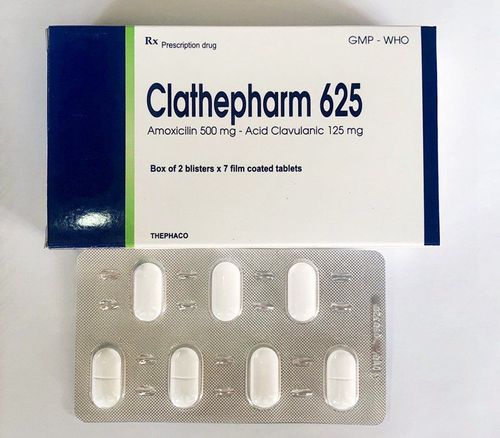This is an automatically translated article.
Clathepharm 625 is indicated for treatment in cases of bronchitis, pneumonia, pleurisy, postpartum infections... However, using Clathepharm 625 can cause some side effects such as diarrhea, nausea and vomiting, increased liver enzymes... Therefore, before using Clathepharm 625, patients should learn carefully the information and be prescribed from the treating doctor.
1. Mechanism of action of Clathepharm 625
What are the effects of Clathepharm 625? The drug Clathepharm 625 contains Amoxicillin and clavulanic acid and is made in the form of film-coated tablets. The drug belongs to the group of anti-infectives, antivirals, and antifungals. Amoxicillin component belongs to the group of antibiotics with broad antibacterial spectrum, resistant to acid environment, especially effective in the prevention of gram-negative bacilli. Similar to other penicillins, amoxicillin is bactericidal by inhibiting the biosynthesis of mucopeptides of the bacterial cell wall. Amoxicillin is active against most gram-negative and gram-positive bacteria such as streptococcus, non-penicillinase-producing staphylococcus, E.coli,... However, amoxicillin is not active against specific penicillinase-producing bacteria. especially methicillin-resistant staphylococcus, pseudomonas...
Clavulanic acid also belongs to the group of antibiotics often used in combination with amoxicillin and has a broad antibacterial spectrum. This acid is produced by the fermentation of Streptomyces clavuligerus which has a beta-lactam structure. They have the ability to inhibit gram-negative bacteria, especially strongly inhibiting plasmid-transmitted beta-lactamases that cause resistance to penicillins and cephalosporins. In addition, Clavulanic acid prevents amoxicillin from being destroyed by beta-lactamases, and effectively extends the antibacterial spectrum for amoxicillin to many species that are normally resistant to amoxicillin or resistant to penicillins and cephalosporins.
2. Indications and contraindications to the use of Clathepharm 625
Clathepharm 625 is indicated in the following cases:
Bronchitis Pneumonia, pleurisy, and lung abscess Tonsillitis, Sinusitis, Otitis media, Cystitis, Urinary tract infection, Nephritis, pyelonephritis, Infectious miscarriage , postpartum infection Broad ligament, cambitis Cellulitis Wound infection Intra-abdominal infection Osteomyelitis Septicemia Post-operative infection. In addition, Clathepharm 625 can be used for prophylaxis in surgery.
However, Clathepharm 625 may be contraindicated in some cases, including: ingredients with hypersensitivity reactions to penicillin or components of Clathepharm 625. In addition, pathological subjects such as leukocytosis Infectious mononucleosis, history of cholestatic jaundice or liver dysfunction due to penicillin use should not use Clathepharm 625.
3. Dosage and usage of Clathepharm 625
The drug is used for both adults and children. Dosage of Clathepharm 625 will be calculated according to the amoxicillin content in the drug.
For adults and children over 12 years old, use Clathepharm 625 for mild infections with a dose of 1 tablet equivalent to 500mg of amoxicillin and the interval between two uses is usually 12 hours. For severe infections, use Clathepharm 625 with a dose of 1 tablet equivalent to 500mg of amoxicillin and the interval between two uses is usually 8 hours. For children 6 years old and weighing less than 25kg, use Clathepharm 625 in suspension or powder form. The drug should be used at the beginning of a meal to minimize drug intolerance when it enters the stomach. Clathepharm 625 should only be used for about 14 days. If this time is exceeded, the patient needs to be re-examined to determine the cause of the disease and have the next effective treatment.
Note: The above recommended therapeutic dose for Clathepharm 625 is for reference only. Therefore, before using Clathepharm 625, patients need to be prescribed by a doctor.
If the patient using Clathepharm 625 forgets a dose, the missed dose can be used as soon as he remembers. However, if the interval between the missed dose of Clathepharm 625 and the next dose is close, the patient can skip the missed dose and take the next dose. Patients should also note that it is not recommended to double the dose of Clathepharm 625, because it may cause drug overdose and unwanted side effects and affect the current health of the patient. .
In case the patient accidentally takes Clathepharm 625 in excess of the prescribed dose and shows some signs of unwanted side effects, it is necessary to take the patient to the nearest medical facility for emergency treatment. timely medical support, helping patients overcome dangerous situations.
Use Clathepharm 625 by swallowing whole tablets or powder in sachets that can be stirred in food, in water, in milk. However, once the package is opened, it must be used immediately.
4. Unwanted side effects and some notes when using Clathepharm 625
Clathepharm 625 can cause unwanted side effects when performing treatment and it is possible that this reaction is common or rare. With common side effects, the reaction is quite mild and temporary.
Hypersensitivity reactions to Clathepharm 625 such as: rash, pruritus, urticaria, erythema multiforme, Steven Johnson syndrome, reactive skin necrosis, bullous dermatitis, exfoliative, generalized pustulosis credit grant. Some subjects may experience angioedema, anaphylaxis, serum sickness, hypersensitivity vasculitis, interstitial nephritis... should stop using the drug and see a doctor to determine the cause.
Gastrointestinal reactions causing symptoms: nausea and vomiting, diarrhea, intestinal candidiasis, colitis when using antibiotics with pseudomembranous colitis and hemorrhagic colitis.
Reactions on the liver can cause hepatitis, cholestatic jaundice. Because Clathepharm 625 also belongs to the group containing antibiotics of the beta-lactam family.
Hematological reactions causing symptoms of transient leukopenia, transient thrombocytopenia, hemolytic anemia, prolongation of bleeding time and prothrombin time.
Reactions affecting the central nervous system with signs of hyperactivity, dizziness, convulsions, And when symptoms of convulsions occur in patients with renal failure or those using the drug in excessive doses.
Clathepharm 625 can interact with Probenecid drugs, birth control pills. However, the drug should not be used together with disulfiram. In addition, the drug Clathepharm 625 may interact with foods, alcoholic or fermented beverages... Therefore, patients should be consulted by their doctor to choose the right medication and avoid side effects. unwanted side.
Please dial HOTLINE for more information or register for an appointment HERE. Download MyVinmec app to make appointments faster and to manage your bookings easily.













